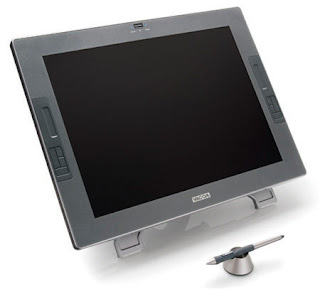Or: How I Learned to Stop Worrying and Love the Cintiq 21UX
El
I was a loud opponent of this idea in the beginning. For thousands of years, artists have fashioned images by grinding dirt into pulverized tree mulch, and done just fine.
The costs didn’t seem to make sense either. Why replace a 25 cent pencil and a two cent piece of paper, with a three thousand dollar monitor?
And the monitors weren’t much to get excited about either. At the time, the best model out was the Cintiq 17SX. It was a lot easier to get used to than drawing on a Wacom tablet, but there was an annoying quarter second lag from when your arm swept across the screen, to when the line appeared.
And the line wasn’t so hot either. The pressure sensitivity wasn’t too good, so everything looked like it was done in Sharpie.
Bummer.
Then this little miracle showed up:

The Cintiq 21UX.
One hour after it was set up at work, I picked up the phone and ordered one for myself at home. Why?
The drawing lag has been diminished to the point that it’s practically unnoticeable.
The pressure sensitivity is fantastic. Using a program like Painter or Sketchbook, you can create images that are indistinguishable from those created with natural media.
The whole thing rotates like an animation disk, so you can pull your lines without contorting your body.
For digital storyboarding, it’s the greatest thing ever.
Why? The short answer is you can make better looking boards faster.
Your thumbnail drawings don’t have to be xeroxed up or redrawn larger. You can just scale the image on screen to thumbnail size, and then zoom in to clean them up –preserving all the spontaneity of the drawing that usually gets lost in the redrawing phase. This alone justifies the cost of the monitor.
Board panels for TV are usually drawn at 3 inches by 4 inches. That’s super tiny, and it means a lot of drawing with your fingers. With the 21UX you can zoom in on your panel and make it 21 inches across! That way you can put your whole arm into the drawing!
Another super kick ass feature is it’s extremely easy to adjust compositions and even shot choices without redrawing. If something isn’t looking right, it’s super simple to cut, paste and resize any element that is ruining your composition. On a paper, minor tweaks and adjustments that would improve a composition mean big investments of time, that frankly, storyboard artists on a TV schedule don’t have. So they don’t get done. Digitally, they only take a few seconds.
You can create lighting effects and shading in seconds that would be very tricky and time consuming to do with markers. Plus – if it doesn’t look right, you can always just delete the layer – and leave your drawing untouched.
Digital versions of model sheets can be dropped in to easily ensure that everything is always on model – which is really handy when you’re drawing a new character.
Existing BG’s can be easily dropped in, so you can finally stop drawing that exact same establishing shot of the house you’ve done a million times before.
Hook up panels can easily be created by copying, pasting and enlarging from the previous panel.
A Word of Warning
It can take some time to adjust to digital storyboarding. Getting used to the Cintiq is the easy part. Getting used to the software and digital file management is the hard part, because your whole life you have been used to grabbing a piece of paper and drawing on it, without giving it a second thought.
On a computer it’s not that easy. There are all sorts of shortcuts, key commands, layer management and naming conventions that you have to get used to. Until that stuff becomes second nature, you have to switch off the artistic side of your brain and turn on the computer side every time you want to do…anything.
How long that takes is really dependant on how computer savvy you are, and how badly you want to learn. But to the never-ending credit of the amazing El Tigre storyboard crew, we didn’t miss a single deadline in the first 26 cartoons!
I can’t post any art until the show is on the air. But when I do, remember, no trees were harmed in the making of this production!
6 comments:
I'm sold, how much when can I buy one!!!! Oh wait I'm poor....actually I've been getting amped about using a wacom for the first time, but man that Cintiq does look and sound amazing.
I agree 100%. I've gone to an all digital production for my 2D thesis project using a Cintiq 15X. I'm using Photoshop for storyboards, Sketchbook for character designs and Flash for all the animation.
Working a mouse all day will yield carpal tunnel. What about drawing on one of these things? Just wondered.
I'd love a Cintiq, but cost is an issue for me so I've decided to try building one from scratch.
I have a 17sx Cintiq and I never had that lag problem. That only happens to me when I was running too many things at once.
Thomas: To answer your question is that it will be easier on your carpal tunnel. I have it myself in both wrists.
I had a lag time problem when I tried the tablet on a pc. It was because Norton was 64 bit instead of 32. (Or the other way around) When I took Norton off, it was fine. I have since gone back to a Mac and have had no problems. The Cintiq is amazing and no artist should be without one.
I bought a single fingered glove when I bought it, but can't seem to find where to get another. If anyone has a website where they sell them, please post.
Thank you.
Post a Comment